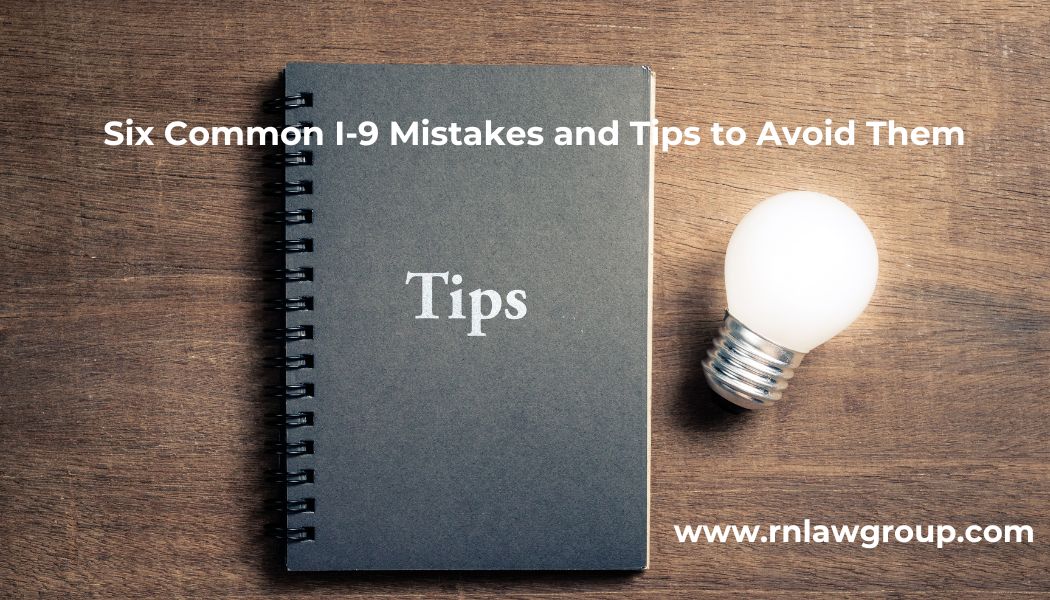
Six Common I-9 Mistakes and Tips to Avoid Them
As HR professionals, you know that onboarding a new employee involves completing Form I-9 to verify the identity and employment authorization of all hired workers. Additionally, employers must reverify work authorization in certain situations, potentially multiple times throughout an employee’s tenure. This process helps ensure compliance and prevents the hiring or retention of unauthorized workers.
Form I-9 violations can lead to substantial civil fines and potential criminal liability. To mitigate these risks, employers must ensure that Form I-9 is accurately completed (Employers Should Strongly Consider Conducting Regular I-9 Internal Audits). The following list outlines common I-9 mistakes and provides tips for avoiding them.
Common Mistake #1 – Tardiness of Completion
You must complete Form I-9 each time you hire any person to perform labor or services in the U.S. in return for wages or other remuneration. As HR professionals, juggling multiple tasks is the norm, so it isn’t surprising that tardiness in completing Form I-9 is a common mistake. But no worries, just remember these two simple rules:
- Section 1 of Form I-9 must be completed by your employee no later than the end of their first day of employment. The employee may complete Form I-9 earlier than the first date of employment as long as they have accepted the job offer.
- Section 2 of Form I-9 must be completed by the employer no later than three business days after the employee begins work for pay. For example, if an employee starts work on Monday, you must review documents and complete Section 2 on or before Thursday. If you hire someone for less than three business days, Section 2 must be completed no later than the first day of employment.
Common Mistake #2 – Re-verifying Employment Authorization Late
In most cases, when an employee’s employment authorization or documentation expires, you must confirm their continued work authorization using Supplement B of Form I-9 (previously Section 3). Employers cannot allow an individual to continue working without valid proof of authorization. To prevent delays in reverification, be sure to:
- Establish a calendar notification system for employees whose employment authorization will expire and provide the employee with at least 90 days’ notice prior to the expiration date.
- Use Supplement B, Reverification and Rehire, and complete it no later than the date employment authorization expires.
Common Mistake #3 – Accepting a Restricted Social Security Card as a “List C” Document
An employee can present a Social Security Card as a “List C” document to demonstrate employment authorization (in combination with a “List B” document to demonstrate identity). However, many employers mistakenly accept restricted Social Security cards, which are not valid for work authorization. Avoid this mistake by following these guidelines:
- Only accept an unrestricted Social Security Card if presented as a “List C” document.
- A restricted Social Security Card is easily recognizable and will include one of the following restrictions:
- Not valid for employment
- Valid for work only with INS authorization
- Valid for work only with DHS authorization
- If presented with a restricted Social Security Card, you must reject the document and ask the employee to choose different documentation from List A or List C.
Common Mistake #4 – Employers Conducting Remote Verification Without Meeting Eligibility Requirements
Normally, employers are required to verify work authorization documents in-person. In 2023, DHS introduced alternative document examination procedures for remote verification. However, employers may not be aware that you must meet certain requirements in order to use this remote verification process. Not fulfilling the in-person review process where required is a substantive violation and can lead to hefty fines. To avoid this mistake, carefully review the DHS guidelines on alternative document verification and ensure compliance before implementing remote verification.
Employers wanting to take advantage of the alternative procedure for remote verification must:
- Be enrolled in and remain in good standing with E-Verify
- Use the alternate option consistently at any given worksite or for remote workers
- Complete an E-Verify tutorial
Note, if employers qualify and use the alternative procedure for remote verification, employers must retain copies of all I-9 documents with the employee’s Form I-9.
Common Mistake #5 – Failure to Comply with Company’s Photocopying Policy
During the I-9 verification process, employees are provided with a list of acceptable documents (List A or List B and C) to present to their employer. Some companies prefer to retain copies of these documents, which is allowed but must be done consistently. To avoid discrimination claims:
- Don’t be selective – If you choose to make copies of documents, you must do so for all employees.
- Create a company-wide policy for photocopying employment verification documents and ensure strict compliance.
- Train key personnel on I-9 rules and internal company procedures.
Common Mistake #6 – Using White-out to Correct Errors on Form I-9
Mistakes happen, but using white-out on Form I-9 is never allowed. Doing so may create suspicion during an official ICE I-9 audit. Instead, follow these best practices:
- Always be transparent – Simply line out the incorrect portion, enter the correct information, and initial and date in the margin. Employees must make corrections in Section 1, and employers in Section 2 and Supplement B.
- Use a new Form I-9 if there are multiple errors or omissions, and attach it to the original.
- Attach a note explaining why changes were made to an existing Form I-9 or why a new one was completed.
What to Do to Ensure Your Company is I-9 Compliant
Employers are fully expected to follow all I-9 rules and procedures. During an I-9 audit, ICE will review I-9 records for substantive and technical errors. Any errors found on Form I-9 can generate hefty fines. However, ICE has been more lenient on employers who take corrective action and implement improved I-9 policies. To ensure compliance, consider conducting a comprehensive internal audit, which should include:
- A full review of the company’s I-9 documents
- Correcting technical errors on Form I-9
- Investigating and addressing substantive errors found on Form I-9
- Evaluating hiring processes and procedures
- Providing HR training on I-9 compliance
- Considering I-9 software to help manage compliance
For more information, please contact Krystal Alanis at krystal@rnlawgroup.com.
By: Krystal Alanis
Krystal Alanis is a Partner at Reddy Neumann Brown PC and manages the firm’s PERM Labor Certification Department, where she oversees all EB-2 and EB-3 employment-based green card matters. Krystal guides clients from a variety of industries through the maze of the PERM Labor certification process and has handled thousands of PERM applications throughout her career with Reddy Neumann Brown PC. Krystal also guides employers and individuals through the I-140 and Adjustment of Status process, and assists clients with temporary work visa petitions (e.g., H-1B, TN, L-1, E-2). With over 13 years of immigration experience, Krystal is able to advise her clients with confidence and recognize any potential pitfalls that may arise.

